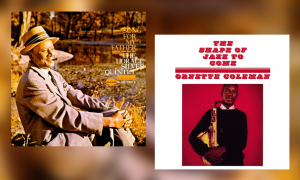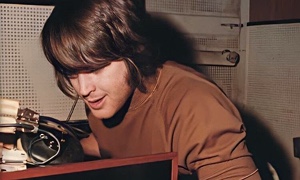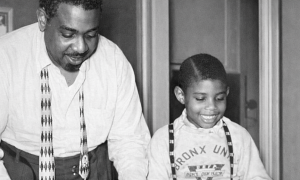Home » Jazz Articles » Building a Jazz Library » Donald Fagen: An Essential Top 10 Albums
Donald Fagen: An Essential Top 10 Albums
I was about 11 when I first started listening to jazz. I lived in New Jersey and used to listen to late- night jazz stations from Manhattan… Jazz affected me in a way that R&B records really didn’t.
—Donald Fagen
The jazz influence on his work has been profound, especially that of Duke Ellington, a version of whose "East St Louis Toodle-Oo" appeared on Steely Dan's third LP Pretzel Logic (see below). He and his musical partner Walter Becker admired the way that Ellington wrote not just tunes but little sub-sections that made them more interesting; that he wrote specifically with certain long-standing band members in mind; that his recordings sound so unified and seamless because the musicians had been playing together for so long, and so regularly.
Fagen also loved Sonny Rollins, whose album Sonny Rollins and The Contemporary Leaders (Contemporary, 1958) is the only one visible in the mocked-up radio studio that features on the cover of Fagen's first solo album The Nightfly. And it's surely no coincidence that the multi- instrumentalist Victor Feldman guests on that Rollins album—just as he appears on all of the first seven Steely Dan albums.
Wayne Shorter was another saxophonist revered by Fagen and Becker. After much pleading, Shorter finally agreed to play on the title track of Steely Dan's Aja album. He was by no means the only jazz legend to end up on one of the band's recordings. Bassist Ray Brown guests on "Razor Boy" from the Countdown to Ecstasy album; Phil Woods plays a celebrated solo on the song "Doctor Wu" from Katy Lied; and Michael Brecker contributes a gorgeously lyrical solo to Fagen's "Maxine" from The Nightfly. There were many others over the years.
In my recent book Nightfly: the Life of Steely Dan's Donald Fagen (Chicago Review Press, 2022) I argue that Donald Fagen's music is comprised not just of jazz, or pop and rock, but is in fact a distillation of a wide variety of styles and genres, including country, blues, soul, R&B, funk, the music of Igor Stravinsky, Henry Mancini TV themes, Burt Bacharach, Bob Dylan, The Beatles and The Rolling Stones. In order to give their own tunes a distinctive faux-jazz sound, Fagen and Becker frequently used an unusual chord which they designated the mü major: actually a major triad with an added 2nd.
Taken as a whole, then, Fagen's work sounds like no one else's. He has never been prolific, and there have been long gaps in his recording career, notably between 1982 and 1993, during which time he released no albums at all. The strain of working on Steely Dan's Gaucho for three years damaged his mental health, and subsequently he experienced severe writer's block. This was largely a result of striving for perfection in the studio. He and Becker would piece together entire tracks from fragments. Even making microscopic adjustments to recorded drum tracks was not good enough for him—he instructed engineer Roger Nichols to build from scratch a rhythm machine called Wendel. And when it came to guitar solos, the two of them would sit for hours while their hired guns ground them out phrase by phrase... Fagen drove himself (and everyone else) crazy. Eventually, however, the muse returned, and three of his four solo albums rank alongside the best of Steely Dan's. Now 74, he has recently dropped hints of a forthcoming new album— possibly including some unheard Fagen-Becker tunes. Another solo release would maintain his steady average of one new set per decade.
This top ten focuses on the jazz elements of what were regarded at the time as rock albums.
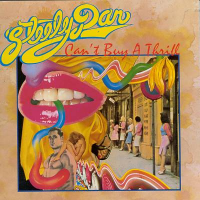 Steely Dan
Steely Dan Can't Buy A Thrill
ABC Dunhill
1972
Once Fagen and Becker had secured their first record deal, they hastily assembled a band and came up with a name for it—Steely Dan. This varied selection of tunes was culled from the duo's four years of writing collaboration at Bard College and in New York, together with some new ones penned after they moved out to California. Can't Buy a Thrill signaled their novel approach to rock from the outset. Victor Feldman was responsible for the distinctive percussion intro to the group's hit single "Do It Again," a modal excursion that gives scope for imaginative solos from guitarist Denny Dias on electric sitar and Fagen himself on Yamaha organ. The breezy latin shuffle of "Only a Fool Would Say That" is another Feldman contribution. Ex-Lunceford, ex-Basie and ex-Thad Jones/Mel Lewis Big Band trumpeter Snooky Young was brought in to provide flugelhorn for the song "Dirty Work," along with fellow Jones/Lewis alumnus Jerome Richardson, who also plays the tenor solo.
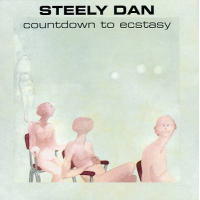 Steely Dan
Steely Dan Countdown to Ecstasy
ABC Dunhill
1973
The band's rockier second album resulted from many unhappy months spent out on the road. The opener, "Bodhisattva," sounds on the face of it like an out- and-out rock number, but the rhythm is essentially swing, with cool accents, and a guitar solo that's only a hair's breadth from bebop. Burt Bacharach's characteristic combination of latin feel with brooding lyrical melancholy on songs like "Walk On By" had not gone unnoticed by Fagen and Becker, and "Razor Boy" is in similar vein, featuring Ray Brown on acoustic bass and Feldman on vibes. There's more latin influence on "Your Gold Teeth," with its jazzy syncopations and extended solos, particularly Fagen's Fender Rhodes wig-out on the fade. Meanwhile jazz saxophonists Ernie Watts and Bill Perkins were recruited to play in the horn section on "My Old School."
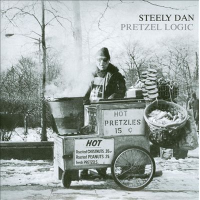 Steely Dan
Steely Dan Pretzel Logic
ABC Dunhill
1974
The group thrown together for Can't Buy a Thrill recorded for the final time on Steely Dan's third album, as Fagen and Becker looked increasingly to session players to create the sound they heard in their heads. Although pictured on the sleeve, the band's drummer Jimmy Hodder was replaced by Jim Gordon in the studio. "Rikki Don't Lose That Number" became one of the biggest hits of Steely Dan's career, its gentle latin rhythm only slightly besmirched by a gonzo guitar solo from Jeff "Skunk" Baxter. The genius of the reinterpreted "East St Louis Toodle-Oo" is that they transcribed the original Ellington band solos and transferred them to electric instruments: Walter Becker reproduces Bubber Miley's trumpet solo on talk-box guitar, while Baxter plays Joe Manton's trombone solo on pedal steel. Otherwise the strongest influence on this album seems to be The Beatles: you can hear echoes of "Lady Madonna" in "With a Gun"; "I Am the Walrus" in "Through with Buzz"; and "Think for Yourself" in "Monkey in Your Soul." But once again the jazz irregulars are strongly in evidence, Plas Johnson joining Ernie Watts and Jerome Richardson in the saxophone section, and Weather Report's Wilton Felder on bass.
 Steely Dan
Steely Dan Katy Lied
ABC Dunhill
1975
Following an abortive attempt to tour the UK and Europe the previous year, Steely Dan's gigging days were over (for now), and they had once again reverted to a duo —plus an ever-growing roster of hired studio hands. Katy Lied was beset by so many technical gremlins that the album was almost abandoned. Fortunately it survived, and once again drew on a wide range of musical styles, from blues shuffle ("Black Friday," "Chain Lightning"), glorious vocal harmony ("Rose Darling"), funk ("Daddy Don't Live in that New York City No More"), bittersweet pop ("Any World that I'm Welcome To") to unabashed jazz waltz ("Your Gold Teeth II"). One highlight of the album is Phil Woods' perfectly-judged alto solo on "Doctor Wu." Fagen and Becker had become so inured to the hours it took to capture what they wanted from guitarists and drummers that they were taken aback when Woods nailed his solo within 15 minutes of arriving at the studio.
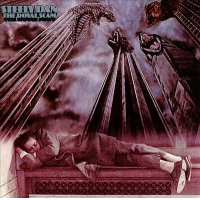 Steely Dan
Steely Dan The Royal Scam
ABC Dunhill
1976
This is a tougher-sounding album than any that had gone before, dominated by the crunching, howling guitar of Larry Carlton, then a member of The Crusaders. Many of the musicians were tried and trusted Steely Dan contributors from across the genres, including guitarist Dean Parks and bassist Chuck Rainey, but here for the first time they were joined by keyboardist Don Grolnik, saxophonist John Klemmer, who solos on "The Caves of Altamira," and soul-funk legend, drummer Bernard Purdie. The tunes are characterized by tricky rhythmic syncopations, particularly "Sign in Stranger," and funky, riff-based numbers like "Green Earrings" and "The Fez." The title track, an angry denunciation of the empty promise of the American Dream, is punctuated by the muted jazz trumpet of Chuck Findley.
 Steely Dan
Steely Dan Aja
ABC Dunhill
1977
As the pop world reeled under the assault of tinny guitar minimalists like The Ramones and The Sex Pistols, Steely Dan were exploring a different musical planet with this, their undisputed masterpiece. It was the synthesis of a decade's work, of all the funk, soul, R&B, jazz and rock they had been blending since their days at Bard College in upstate New York. Aja is lush and mysterious, a thoughtful, reflective work of mature consciousness, an album on which they allowed themselves and their musicians time to stretch out a little. This is particularly true of the eight-minute title track, which features Joe Sample on Fender Rhodes, Larry Carlton on guitar, and Victor Feldman on marimba, with iconic solo contributions from Wayne Shorter and drummer Steve Gadd. Six different drummers were used over the seven tracks. Pete Christlieb was recruited to play the tenor solo on "Deacon Blues," another track that clocks in at more than 7 1/2 minutes, fading on a serene, opulent horn arrangement by Tom Scott. Fagen knew exactly how he wanted them to sound: closely harmonized like Oliver Nelson's ensemble on Blues and the Abstract Truth.
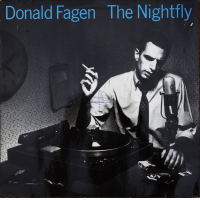 Donald Fagen
Donald Fagen The Nightfly
Warner Bros
1982
The story of Steely Dan's flawed Gaucho album is long and tortured, as were the personal traumas that visited Walter Becker, who had now retired hurt to Hawaii. Fagen, who was about to suffer problems of his own, surprised many with the beauty and jazz-saturated hipness of this, his first solo outing. The Nightfly proved that Fagen could make a great album without Becker. It is, first and foremost, a nostalgia suite about the fantasies of his childhood and early adolescence. Among the many highlights: a reharmonised version of Leiber and Stoller's "Ruby Baby," on which Fagen sings all the dense vocal harmony; the fast ska tune "Walk Between the Raindrops," that is almost swing, but not quite; the shimmering romantic ballad "Maxine," another vocal tour de force, with Marcus Miller on bass, Randy Brecker and Michael Brecker on trumpet and tenor, and Ronnie Cuber on baritone. The title track tells the tale of a lovelorn all-night jazz DJ of the type young Fagen used to listen to under the bedclothes in suburban New Jersey.
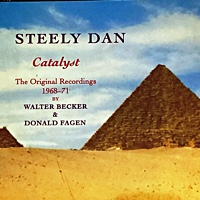 Walter Becker and Donald Fagen
Walter Becker and Donald Fagen Catalyst: The Original Recordings 1968-71
Magnum America
1995
This is a controversial choice, one with a history. A year after Fagen's long creative drought began, an album of unofficial demo recordings appeared under the name Walter Becker/Donald Fagen—The Early Years. The rights were owned by Kenny Vance, their manager before they had a record deal. In the years that followed, more demos were released around the world in various combinations on a bewildering variety of labels, all apparently without Vance's permission. The sound quality on most is poor, but the songwriting is impressive, and signposts the sonic world of the future Steely Dan. For fans, these recordings not only filled the void that had existed since Fagen and Becker's split, but offered them a glimpse of the duo's raw, innocent genius in embryo. The 29-track Catalyst compilation (inaccurately credited to Steely Dan) is included here as the most comprehensive collection of these demos, featuring versions of "Brooklyn (Owes the Charmer Under Me)," "Barrytown," "Any World (That I'm Welcome To)," "The Caves of Altamira," "Charlie Freak," and "Parker's Band." Unreleased treats from the pre-Steely Dan era include the sweet and mystical "Sun Mountain," the sci-fi influenced "Android Warehouse" and the obscure, dramatic "Roaring of the Lamb."
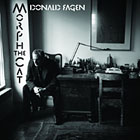 Donald Fagen
Donald Fagen Morph the Cat
Reprise
2006
Fagen's second solo album Kamakiriad lacks the memorable tunes and autobiographical intimacy of The Nightfly. There are several excellent songs on the two Steely Dan reunion albums, but on the whole Morph the Cat is a warmer and more relaxed affair, with better melodies, such as the title track, "Mary Shut the Garden Door," and "Security Joan." Musically, Fagen had by now fallen out of love with the drum machines and synthesizers that had dominated the previous two decades, and craved a return to real, tunable instruments. The musicians he hired these days were able to switch seamlessly between jazz and rock styles, among them guitarist Jon Herington, who had also played with the likes of saxophonists Bob Berg and Bill Evans, and guitarist Mike Stern. Trumpet player Marvin Stamm and bassist Freddie Washington also had extensive CV's with jazz titans from Freddie Hubbard to Herbie Hancock.
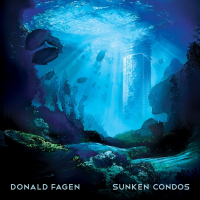 Donald Fagen
Donald Fagen Sunken Condos
Reprise
2012
Sunken Condos is less of a solo album, more of a collaboration with his long-time sideman, the trumpeter Michael Leonhart, who also plays drums and a variety of keyboard instruments. Sunken Condos maintains the feeling of close-miked warmth and maturity that brings Morph the Cat alive. All Fagen's songwriting trademarks are here: typically a one-chord groove on the A section, with modulations, harmonies and horn backings on the bridge—"Slinky Thing" and "Good Stuff" are examples. The album features a guest appearance by Kurt Rosenwinkel on guitar ("Planet D'Rhonda"), plus the usual long list of experienced jazzers, including Jim Pugh on trombone, Walt Weiskopf on tenor, and bass veteran Jay Leonhart (father of Michael) on "The New Breed." The cool vibes on "Planet D'Rhonda" are courtesy of Jay's multi-talented son.
Tags
Building a Jazz Library
Donald Fagen
Peter Jones
United States
Chet Baker
steely dan
duke ellington
Walter Becker
Sonny Rollins
Victor Feldman
Wayne Shorter
Ray Brown
Phil Woods
Michael Brecker
Henry Mancini
Burt Bacharach
Bob Dylan
The Beatles
The Rolling Stones
Denny Dias
Snooky Young
Jerome Richardson
ABC Dunhill
ernie watts
Bill Perkins
Bubber Miley
Joe Manton
Plas Johnson
Wilton Felder
Larry Carlton
The Crusaders
Dean Parks
Chuck Rainey
Don Grolnik
John Klemmer
Bernard "Pretty" Purdie
Chuck Findley
Joe Sample
Steve Gadd
Pete Christlieb
Tom Scott
Oliver Nelson
Warner Bros
Marcus Miller
randy brecker
Ronnie Cuber
Magnum America
Reprise
Jon Herington
Bob Berg
Bill Evans
Mike Stern
Marvin Stamm
Freddie Washington
Freddie Hubbard
Herbie Hancock
Michael Leonhart
Kurt Rosenwinkel
Jim Pugh
Walt Weiskopf
Jay Leonhart
PREVIOUS / NEXT
Support All About Jazz
 All About Jazz has been a pillar of jazz since 1995, championing it as an art form and, more importantly, supporting the musicians who make it. Our enduring commitment has made "AAJ" one of the most culturally important websites of its kind, read by hundreds of thousands of fans, musicians and industry figures every month.
All About Jazz has been a pillar of jazz since 1995, championing it as an art form and, more importantly, supporting the musicians who make it. Our enduring commitment has made "AAJ" one of the most culturally important websites of its kind, read by hundreds of thousands of fans, musicians and industry figures every month.












